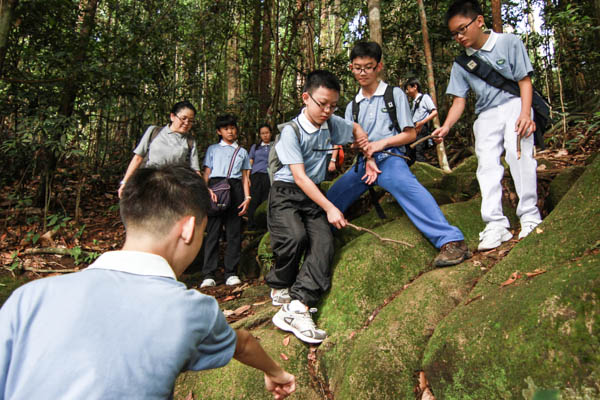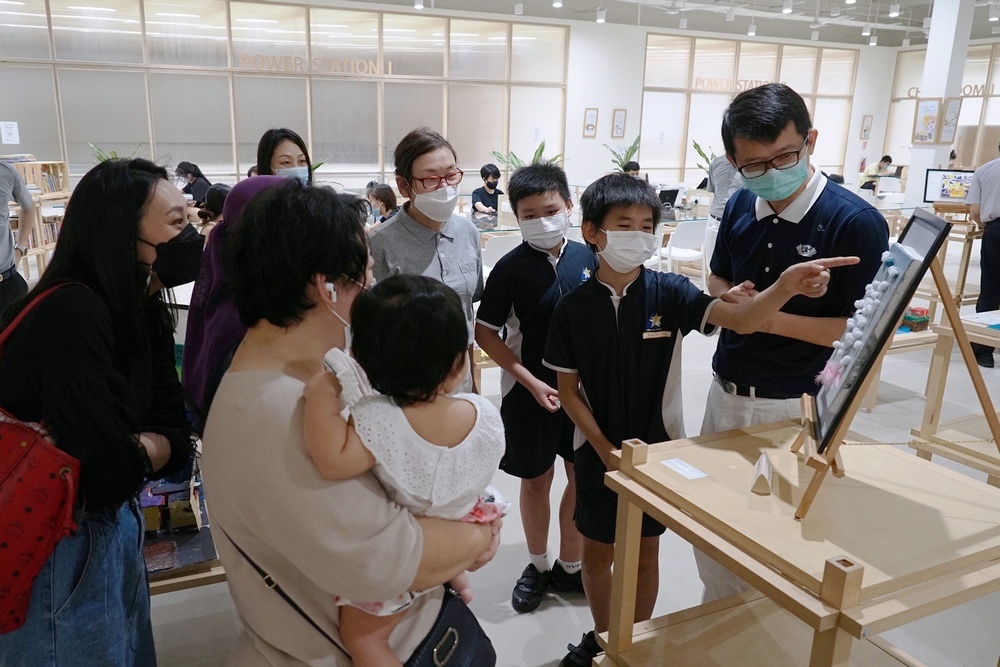
Li Shaowei (Left) explains to his peers how a cabbage head is originally dark green on the outside, but becomes near-white only after a “beautification” process. (Photo by Chua Yek Guo)
More than 90% of the food consumed in Singapore is imported, but little do people know about the journey food takes from farm to table. After a 3-year hiatus, it was on the morning of 16 May, 2015, that 40 youths from the Tzu Chi Collegiate Association once again gathered at the Pasir Panjang Wholesale Centre, on a VERO* mission to explore the various stages of food production, from the primary source to the end-product.
“I’m durian!” “Then I’m bean sprouts!” “And I’m papaya!”
The energetic and lively VEROs started their fifth quest to understand “The Food Journey” with an ice-breaker where everyone took turns to introduce themselves using a kind of farm produce. Then, with an enthusiastic cry of “Go Green, Be Bold!”, they kicked off their Journey for the day.

The VEROs, accompanied by their mentor, approached stall holders at the Pasir Panjang Wholesale Centre in order to learn more about the agricultural industry and its processes. (Photo by Lian Ya Hui)

With an enthusiastic cry of “Go Green, Be Bold!”, the VEROS began The Food Journey. (Photo by Chua Yek Guo)
Foods in Their Original Form
Members of the Tzu Chi Collegiate Association, aka Tzu Chings, had organized a variety of experiential activities to be conducted during the tour of the Pasir Panjang Wholesale Centre. These activities allowed the participants to see how the various foodstuffs that are so readily available to them look like in their original form.
At the first station, the youths reached the dried goods section, and were presented with an array of baskets of nuts. They excitedly approached and began eyeing the various types of nuts and spices.
“Do you know how these nuts looked like in their original form?” Tzu Ching senior Jiang Weijie posed a small test to the participants. The various nuts included walnuts, pistachios, almonds, and many others. With the help of a tablet, everyone was surprised to see the beautiful, vibrant flowers on the trees that bore the fruits containing the nuts. No one would even think of associating these images with the hard, dry nuts they so often consumed.
It was not just these dried goods that were “transformed” before reaching consumers. Fruits and vegetables that are commonly available also went through a “beautification” process, unbeknownst to the average consumer. Take cabbage for example. Before harvesting and processing, its outermost leaves are actually dark green in colour. However, the cabbages that we buy appear close to white, and it is only after all the processing (which reduces their weight by about half) that they can be sold to the consumer markets.
At one far corner of the Wholesale Centre, a vegetable seller was painstakingly removing any leaves that had yellowed slightly or had some form of blemish or other.
“If I don’t pluck away these leaves, when the vegetables are sent to the markets and supermarkets, they won’t sell. In the past, there would still be many who would come to the Wholesale Centre to purchase farm produce, but the numbers of such customers have drastically dwindled,” the elderly seller lamented the change brought about by time.
Looking at the growing heap of discarded leaves on the ground, NTU student Zhong Shuyun exclaimed, “We will be able to reduce a lot of wastage if we purchase straight from this Centre!”

A stallholder meticulously checking some vegetables and removing every blemished part. (Photo by Lin Cen Ling)

Lin Tianshui (extreme right) explains how produce has to be kept in a refrigeration unit, which requires vast amounts of water and energy. (Photo by Lin Cen Ling)
Adhering to High Aesthetic Standards
Aside from cabbages, other common vegetables, such as spinach, also go through such a “stripping process” before reaching the consumers. The VERO youths spotted an elderly man next to a spinach stall carefully plucking off blemished leaves, and then packing the vegetables into boxes. Curious, they approached him to find out more.
“This spinach comes from Cameron Highlands in Malaysia, I’m preparing it to be used on a ship,” said the man. He went on to share how he could sort up to two or three baskets of vegetables a day, with every basket taking him about half an hour. His roughened fingers were a result of years of such work.
Behind the fruit wholesaler stood a two-storey high refrigeration unit. “The temperature in the interior is about 4 degrees Celsius, and the streaks of water on the floor come from melted ice,” explained Lin Tianshui, owner of the agricultural produce. After the produce was sorted and packaged, it was stored in a container with blocks of ice. Many of the fruits were imported from temperate regions, such as Africa, America and Europe, so the energy and water resources needed simply to preserve their freshness were immense.
“Singapore no longer has seasonal imports, because the same kind of fruit can be imported all year round from different countries experiencing different seasons,” Lin elaborated. However, unlike vegetables, where the less desirable portions can be easily removed, the whole fruit has to be discarded so long as any part of it is unsatisfactory.
“I feel it is such a pity that these fruits and veggies are simply thrown away due to minor blemishes,” commented Yang Xiaoqi, a Malaysian student from Nanyang Polytechnic. Thus she reminded herself to never waste the food on her plate again.

Over the years, the fingers of the workers are roughened by work and abrasion as they prepare vegetables for sale. (Photo by Lian Ya Hui)

Yang Xiaoqi (second from left), a Malaysian student from Nanyang Polytechnic, reminded herself to never waste food again after witnessing how portions of vegetables are removed and discarded due to minor blemishes. (Photo by Lin Cen Ling)
Reducing Food Wastage Benefits All
Upon completion of the tour, the VEROs returned to the student hostel at the National University of Singapore (NUS) to discuss and share with one another their experiences of and reflections on the activity.
“Miss, did any of these vegetables catch your eye?” asked a vegetable stall owner. “All the cabbages that you have here don’t look appealing at all, and they even have small black spots!” nitpicked a white-collar female customer. The rejected stall owner quickly turned to his suppliers, who could only say to the farmers that if they did not start adding copious amounts of pesticides, they would be out of business soon.
This short skit put up by the students illustrated the feedback loop from the consumers to the farmers, who were no longer growing produce just to feed hungry stomachs, but also to satisfy the rising demands of the consumers.
Huang Xiaoyan, the emcee for the day, shared about a special farmers’ market located in France. “To help consumers realise that fruits and veggies that look unappealing may not be inedible, and to take steps to reduce food wastage, the farmers there sold produce that did not make the commercial cut at a 30% discount. They managed to sell an average of 1.2 tonnes of produce per stall in a mere two days.”
“We humans waste too much food; just because of a moment of pickiness we generate so much waste,” remarked Yang Xiaoqi.
Not only are people wasting food, the effects of climate change in recent years have also severely affected the agricultural industry and destabilized food prices. In a video shown to all, Xie Jinggui, a senior Tzu Chi volunteer from Taiwan, highlighted that due to climate change, those countries with large agricultural industries were reducing their produce exports. This affected many other countries which rely heavily on imported food, and exacerbated food shortages in the poorer, developing countries.
As the world is a global village, everyone needs to remain vigilant during peaceful times and prevent wastage of food. In the video, Xie also promoted the reduction of reliance on imported food, encouraging people to consume local produce.

Participant Zhong Shuyun (second from left) commented that people should let go of their attachment to outer appearances and the habit of nitpicking at the smallest things, and that such a change in attitude would greatly benefit humanity and the Earth in the future. (Photo by Chua Yek Guo)

The VEROs discussed and shared with one another their reflections on the day’s activity. (Photo by Chua Yek Guo)
Going Green in Daily Life
As “The Food Journey” drew to a close, Tzu Ching senior Li Shaowei explained the relevance of vegetarianism to saving the Earth. He raised an example, saying, “Producing 1 kilogram of beef requires 7 kilograms of wheat and 16 kilograms of water, while simultaneously generating 13 kilograms of carbon dioxide and methane gas, 40 kilograms of excretory waste, and 35 kilograms of polluted topsoil.”
Rearing animals to satisfy human desire for meat not only consumes a lot of resources that could have been used to feed people, but also contributes largely to the production of greenhouse gases. “Statistics show that the amount of greenhouse gases produced by livestock exceeds even that produced by the transport sector,” added Li, who is currently engaged in environmental research at NTU. He further said, “The rearing of livestock not only results in large amounts of greenhouse gas emissions, but also in the clearing of large areas of forest.”
According to current data, the world population is now at 7.3 billion, but the numbers of livestock far exceed human population – there are now 1 billion pigs, 1.4 billion cows, 1.1 billion sheep, and 19 billion chickens being raised for the meat industry. By these estimations, about 2000 animals are turned into dishes every second.
To conclude, Tzu Ching senior Chen Zhixun said, “There is a difference between knowing and feeling. We understand that hunger is hard to bear, but to actually feel it is another level of experience. After participating in today’s learning journey, not only have we gained a better understanding of the problem of food wastage, but we have also witnessed with our own eyes the severity of the problem.”
Chen further encouraged everyone to share what they have learned with their family and friends, so that more people could learn about it and practise it in their daily lives.
Participant Zhong Shuyun shared, “We should let go of our attachment to outer appearances and the habit of nitpicking at the smallest things. Such a change in attitude will greatly benefit humanity and the Earth in the future.”
After seeing the statistics, such as the sheer amount of food wasted every year, Zhong was prompted to reflect on and improve her spending habits, and to influence others around her to do the same.

Transporting, packaging, packing, and storing farm produce result in a lot of resource wastage. (Photo by Lian Ya Hui)
A cabbage head loses half its weight after the “beautification process”. (Photo by Lin Cen Ling)
* In April 2011, the Tzu Chi Collegiate Association in Singapore launched a campaign to promote vegetarianism and coined it VERO (Veggie Hero). Through the accumulation of vegetarian meals and other interesting activities, such as cook-offs and food trails, VEROs strive to spread the word about the benefits of vegetarianism. The campaign is now in its fifth year.


